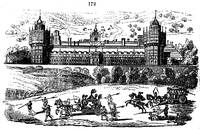554. During the reign of Henry VIII, (1509 to 1547), the royal gardens of Nonesuch were laid out and planted. 'Nonesuch,' says Hentzner, 'was built by Henry VIII. with an excess of magnificence and elegance even to ostentation; as one would imagine every thing that architecture can perform to have been employed in this one work. There are every where so many statues that seem to breathe, so many miracles of consummate art, so many casts that rival even the perfection of Roman antiquity, that it may well claim and justify its name of Nonesuch, being without an equal; or, as the poet sung, 'This, which no equal has in art or fame, Britons deservedly do Nonesuch name.' The palace itself is so encompassed with parks full of deer, delicious gardens, groves ornamented with trellis-work, cabinets of verdure, and walks so embowered by trees, that it seems to be a place pitched upon by Pleasure herself to dwell in along with Health. In the pleasure and artificial gardens are many columns and pyramids of marble, two fountains that spout water one round the other like a pyramid, upon which are perched small birds that stream water out of their bills. In the grove of Diana is a very agreeable fountain, with Actï¾µon turned into a stag, as he was sprinkled by the goddess and her nymphs, with inscriptions. There is, besides, another pyramid of marble full of concealed pipes, which spirt upon all who come within their reach.' Lysons, in his Environs of London, informs us that 'in Sebastian Braun's work, entitled Civitatis Orbis Terrarum, there is an engraving of Nonesuch Palace,' from which he gives a plate (fig. 172.). There is also a small engraving of the same palace, with part of its gardens, in the corner of Speed's Map of Surrey. Braun, speaking of Nonesuch, says, that by a contrivance of the architect, an echo was made at the entrance of the palace, which repeated the sound distinctly five or six times. (Lysons.) These gardens are stated, in a survey taken in the year 1650, above a century after Henry's death, to have been cut and divided into several alleys, compartments, and rounds, set about with thorn-hedges. On the north side was a kitchen-garden, very commodious, and surrounded with a wall fourteen feet high. On the west was a wilderness severed from the little park by a hedge, the whole containing ten acres. In the privy-gardens were pyramids, fountains, and basins of marble, one of which is 'set round with six lilac trees, which trees bear no fruit, but only a very pleasant smell.' In the privy-gardens were, besides the lilacs, 144 fruit-trees, two yews, and one juniper. In the kitchen-garden were seventy-two fruit-trees and one lime tree. Lastly, before the palace, was a neat handsome bowling-green, surrounded with a balustrade of freestone 'In this garden,' observes Daines Barrington, 'we find many such ornaments of old English gardening, as prevailed till the modern taste was introduced by Kent.' It is singular that Nonesuch, so celebrated as an example of the ancient style of gardening, in the the sixteenth century, should have been changed to the modern style in the eighteenth century by the first and the best of all the writers on this style, Thomas Whately, Esq., author of Observations on Modern Gardening, to whose brother Nonesuch belonged in 1786. (See Gard. Mag., vol. vii. p. 430.)

